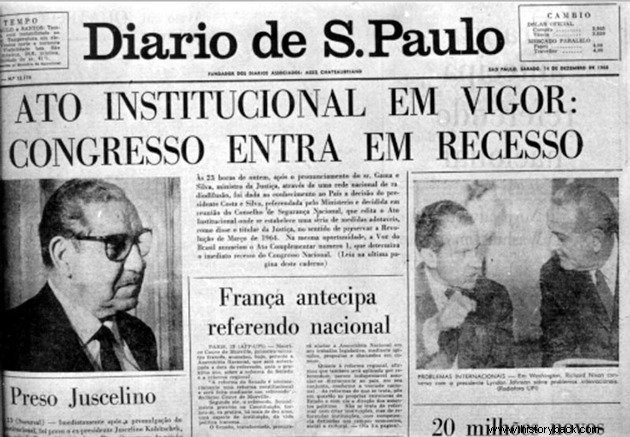The Institutional Act nº 5 was published on December 13, 1968, signed by President Costa e Silva and marked the hardest phase of the period of military dictatorship in Brazil.
The trigger for AI-5 was the proposal to boycott the military by deputy Márcio Moreira Alves (1936-2009).
AI-5 Summary
With the enactment of AI-5, the president acquired powers such as:
- revokes legislative, executive, federal, state and municipal mandates;
- suspend the political rights of citizens, dismiss, remove, retire civil and military officials;
- fire and remove judges;
- decree a state of siege without country restrictions;
- seize assets to punish corruption;
- legislate by decree and download other complete institutional acts.
With regard to the rights of ordinary citizens, the AI-5 violated the most elementary civil guarantees. Let's see:
- the government has withdrawn the right to habeas corpus (provisional release while responding to the process) to those accused of crimes against national security;
- the accused began to be tried by military courts without the right to appeal.
On the same day as the publication of the act, President Arthur da Costa e Silva closed the National Congress, legislative assemblies and municipal councils.
In the same way, he put the police and the Armed Forces on standby.
See also:Military Dictatorship in Brazil (1964-1985)Consequences of AI-5
With the enactment of AI-5, the most repressive period of the Brazilian dictatorship began, known as the years of lead.
Resistance to the dictatorship increased and began to incorporate students and members of the middle class. In addition to repression, the military failed to provide the responses demanded by society to the economic crisis that led to the coup.
Workers began to convene demonstrations against the devaluation of wages in acts harshly repressed by the police.
Several opposition movements were put underground. Furthermore, some chose the path of violence to fight the dictatorship by carrying out kidnappings of diplomats, bank robberies, etc.
The reactions began to be carried out by armed guerrillas, such as the VPR (Vanguarda Popular Revolucionaria) and the ALN (Ação Libertação Nacional). In the 70's, there was an attempt to revolt the rural environment through the Guerrilha do Araguaia.
The AI-5 would only be revoked during Ernesto Geisel's government, as he judged that Brazil was free from the 'communist danger'.
See also:Freedom of ExpressionInstitutional Acts

Institutional Act nº 5 is part of the set of measures applied by the government during the Brazilian military dictatorship.
The Brazilian dictatorial regime used these decree-laws, the 1967 Constitution and strong repression of its opponents to guarantee its permanence in power.
See also:Military coup of 1964The Institutional Acts were laws elaborated by the Executive Power that were above other laws and norms. Supported by the National Security Council, the Brazilian dictatorship decreed 17 institutional acts .
Let's look at the first four:
Institutional Act nº1
The first Institutional Act of the military government was enacted on April 9, 1964, when the National Congress was convened to elect a new president. General Humberto Castelo Branco was elected on the occasion.
This Institutional Act granted broad powers to the Executive to decree a State of Siege and suspend the political rights of citizens for up to ten years.
It also allowed the president to revoke political mandates, suspend constitutional guarantees, dismiss, dismiss, reform or transfer public servants.
Likewise, with this law, the mandates of 41 deputies were revoked.
Institutional Act nº 2
The actions of the military led to popular reactions, mainly through the popular vote. In the gubernatorial elections held in 1965, government candidates were defeated in 11 states.
The government reacted by issuing Institutional Act No. 2 on October 27, which determined that the presidential election would become indirect.
Political parties were also extinguished. In this context, the creation of two parties was determined, the Arena (Aliança Renovadora Nacional), with the support of the government and the MDB (Brazilian Democratic Movement), which was the opposition.
For its part, the trials of civilians were transferred to the Military Justice.
Institutional Act No. 3
Dating from February 1966, it determined that the gubernatorial elections be indirect.
Institutional Act No. 4
In 1966, General Costa e Silva was elected president and the 1946 Constitution was revoked.
Through Institutional Act nº 4, on January 24, 1967, a commission was convened to prepare a new constitutional text and grant it. The Magna Carta came into force in March 1967, when Costa e Silva took office.
See also:Constitution of 1967Curiosities
- Among the main highlights for the registration of the AI-5 edition is the December 14, 1968 edition of Jornal do Brasil. That day, despite the summer, the weather forecast said:“Dark weather. Stifling temperature. The air is unbreathable. The country is being swept by strong winds” .
- Several professionals such as university professors Florestan Fernandes and Fernando Henrique Cardoso were compulsorily retired with AI-5.
Read further:
- Direct Now
- Economic Miracle
- Music from the Military Dictatorship
- Dilma Rousseff
- Operation Condor
- Questions about the Military Dictatorship
